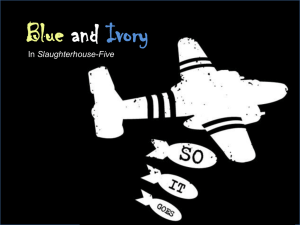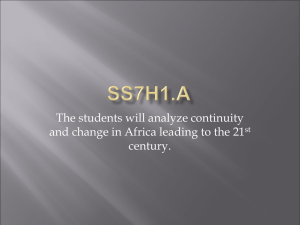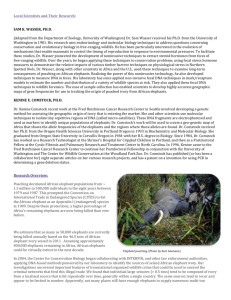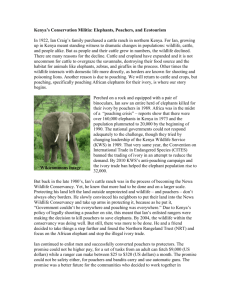Testimony of David J. Hayes Before the Subcommittee on Fisheries
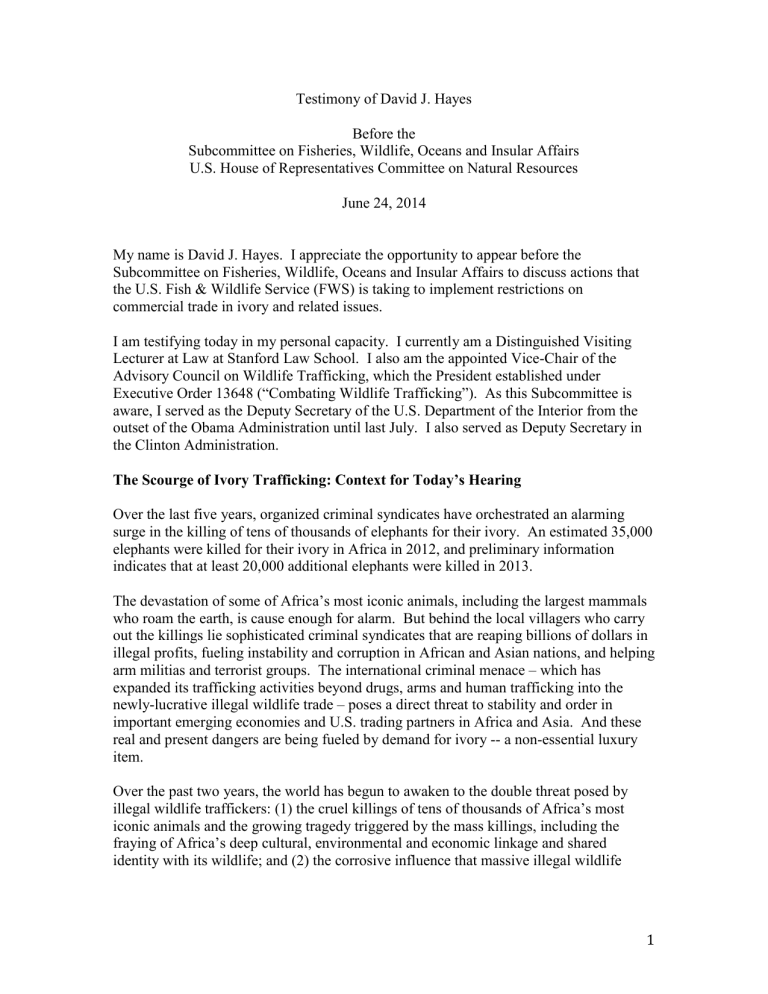
Testimony of David J. Hayes
Before the
Subcommittee on Fisheries, Wildlife, Oceans and Insular Affairs
U.S. House of Representatives Committee on Natural Resources
June 24, 2014
My name is David J. Hayes. I appreciate the opportunity to appear before the
Subcommittee on Fisheries, Wildlife, Oceans and Insular Affairs to discuss actions that the U.S. Fish & Wildlife Service (FWS) is taking to implement restrictions on commercial trade in ivory and related issues.
I am testifying today in my personal capacity. I currently am a Distinguished Visiting
Lecturer at Law at Stanford Law School. I also am the appointed Vice-Chair of the
Advisory Council on Wildlife Trafficking, which the President established under
Executive Order 13648 (“Combating Wildlife Trafficking”). As this Subcommittee is aware, I served as the Deputy Secretary of the U.S. Department of the Interior from the outset of the Obama Administration until last July. I also served as Deputy Secretary in the Clinton Administration.
The Scourge of Ivory Trafficking: Context for Today’s Hearing
Over the last five years, organized criminal syndicates have orchestrated an alarming surge in the killing of tens of thousands of elephants for their ivory. An estimated 35,000 elephants were killed for their ivory in Africa in 2012, and preliminary information indicates that at least 20,000 additional elephants were killed in 2013.
The devastation of some of Africa’s most iconic animals, including the largest mammals who roam the earth, is cause enough for alarm. But behind the local villagers who carry out the killings lie sophisticated criminal syndicates that are reaping billions of dollars in illegal profits, fueling instability and corruption in African and Asian nations, and helping arm militias and terrorist groups. The international criminal menace – which has expanded its trafficking activities beyond drugs, arms and human trafficking into the newly-lucrative illegal wildlife trade – poses a direct threat to stability and order in important emerging economies and U.S. trading partners in Africa and Asia. And these real and present dangers are being fueled by demand for ivory -- a non-essential luxury item.
Over the past two years, the world has begun to awaken to the double threat posed by illegal wildlife traffickers: (1) the cruel killings of tens of thousands of Africa’s most iconic animals and the growing tragedy triggered by the mass killings, including the fraying of Africa’s deep cultural, environmental and economic linkage and shared identity with its wildlife; and (2) the corrosive influence that massive illegal wildlife
1
trafficking is having on important U.S. interests in Africa and Asia, spawned by the traffickers’ unholy alliances with militias, terrorist groups and corrupt officials.
Then-Secretary of State Hillary Clinton first drew attention to these emerging threats in an important State Department address in November 2012. She triggered the U.S. intelligence agencies’ analysis and subsequent confirmation of the ties between the criminal syndicates involved in wildlife trafficking and their connection with militia and terrorist groups. Simultaneously, leaders in the United States Department of the Interior -
- which oversees African wildlife programs through its Fish & Wildlife Service and is the
U.S. lead in implementing the international convention that restricts trade in endangered species (CITES) – also sounded the alarm within the Administration. More specifically, while visiting in Tanzania as Deputy Secretary in early 2013 on behalf of FWS’s Africa program, I learned first hand about the mass killings of elephants in Africa and resusitation of the illegal ivory trade, and returned to the United States, committed to work with the White House and take on the issue.
A few months later, the President used the opportunity of his visit to Africa to make combatting international wildlife trafficking a priority for the Administation. See
Executive Order 13648 (“Combating Wildlife Trafficking”)(July 1, 2013). Section 1 of the President’s Order speaks clearly and strongly to the threat that the international wildlife trafficking scourge poses to U.S. interests. It states:
“The poaching of protected species and the illegal trade in wildlife and their derivative parts and products (together know as “wildlife trafficking”) represent an international crisis that continues to escalate. Poaching operations have expanded beyond small-scale, opportunistic actions to coordinated slaughter commissioned by armed and organized criminal syndicates. The survival of protected wildlife species such as elephants, rhinos, great apes, tigers, sharks, tuna and turtles has beneficial economic, social and environmental impacts that are important to all nations. Wildlife trafficking reduces those benefits while generating billions of dollars in illicit revenues each year, contributing to the illegal economy, fueling instability, and undermining security.
Also, the prevention of trafficking of live animals helps us control the spread of emerging infectious diseases. For these reasons, it is in the national interest of the
United States to combat wildlife trafficking.” (Emphasis added.)
The President took several concrete steps in his Executive Order to give teeth to his policy pronouncement, including: (1) the formation of a cabinet-level Presidential Task
Force on Wildlife Trafficking (Task Force) – chaired by Secretaries Kerry and Jewell and
Attorney General Holder; (2) a directive that the Task Force develop and then implement a National Strategy to Combat Wildlife Trafficking; and (3) the formation of an Advisory
Council on Wildlife Trafficking to assist the Administration in developing and implementing the National Strategy. The President’s Executive Order also directed the
Task Force to explore how best to fold wildlife trafficking into the Administration’s previously-announced initiative on “Transnational Organized Crime.”
2
The Task Force and Advisory Council heeded the President’s call and, on February 11,
2014, the White House released the National Strategy for Combating Wildlife
Trafficking. The National Strategy lays out an ambitious agenda, identifying 3 strategic priorities to guide the U.S. response to the global wildlife trafficking crisis: (1)
Strengthen Enforcement; (2) Reduce Demand for Illegally Traded Wildlife; and (3)
Expand International Cooperation and Commitment. The National Strategy then builds out 24 key implementation areas under the three strategic priorities. Adding to the mix, the Advisory Council took action on June 9, 2014 and formally endorsed 19 specific recommendations to implement the National Strategy and move forward with a comprehensive, multi-front war on wildlife traffickers.
FWS Actions to Implement the Ban on Commercial Trade in Ivory
As noted above, tightening up existing restrictions on commercial trade in ivory represents one element of a whole-of-government, multifaceted effort to combat illegal wildlife trafficking. Ending the slaughter, corruption and funding of militias and terrorist groups caused by illegal traffickers required attention on all of the three strategic priorities identified in the recently-released National Strategy document: (1) Strengthen
Enforcement; (2) Reduce Demand for Illegally Traded Wildlife; and (3) Expand
International Cooperation and Commitment.
That said, restrictions in commercial trade in ivory play an important role in the overall effort because they focus U.S. and world-wide consumer attention on the devastating impact that ivory sales are having on elephant populations and de-glamortize the purchase of ivory. Restrictions on ivory trade also dramatically shrink the legal market for ivory products, thereby unmasking the “cover” that legal or pseudo-legal markets now provide for ivory traffickers. Doing so unleashes enforcement efforts in the United
States, and world-wide, against the movement and sale of ill-begotten ivory.
Previous experience validates the important role that restrictions on ivory trade can have in striking back at illegal wildlife traffickers. More specifically, in 1989, the world community responded to a previous surge in elephant killings in Africa by uplisting elephants to Appendix I status under the CITES convention and banning commercial imports and exports of ivory. The 1989 ban had a dramatic impact. Ivory markets in the
U.S. and Europe collapsed. With the ban in place, poaching rates declined precipitously and elephant populations in Africa stabilized at around 600,000 (down from a peak of 1.2 to 1.3 million elephants in the late 1970s). Elephant populations then remained relatively healthy for nearly 20 years – with greatly reduced ivory-related killings – until poaching rates began to escalate rapidly again around 2008, accelerating to today’s massive levels of killings, which are threatening the continued existence of elephants in the African wild.
A number of factors have come together since 2008 to trigger the spiking in elephant killings. Two of the most important factors revolve around erosion of the 1989 ban on commercial trade in ivory. The most striking undermining of the ivory ban occurred in
1999 and again in 2008, when CITES allowed sales of national stocks of ivory in the
3
hope that adding more legal ivory into the market on a tightly regulated basis would moderate demand, bring down prices, and demonstrate that a regulated ivory market could be successful.
The experiment was a disaster. The introduction of new, legal ivory undermined the world-wide ban on commercial trade in ivory and provided cover for illegal syndicates to dramatically increase elephant killings and sales of illegal ivory. Efforts to track and regulate the legal ivory that entered the marketplace in 1999 and again in 2008 failed spectacularly, with China, at one point, being unable to account for a significant amount of the ivory that it had purchased.
In addition, the weakening of the ban on ivory trade unfortunately coincided with the rapid rise of a newly wealthy middle and upper class in Asia which has fueled increased demand for ivory. The potential market is huge, and the run-up in the price in ivory with no apparent slowing of demand, indicate that demand for ivory is inelastic. So long as ivory is available for sale and viewed as an acceptable purchase, the voracious market will continue to incentivize criminal syndicates to kill elephants for their ivory in record numbers – threatening the viability of the species in Africa.
These developments have led experts to agree that elephant killings will continue at a high rates unless the U.S. and other nations double down on the 1989 ban on commercial trade while, at the same time, launching a sophisticated demand reduction strategy.
Parties to the CITES convention are taking steps in this direction, demanding that a number of nations that have clearly been violating the 1989 ban – including China,
Vietnam, Kenya and Tanzania, among others – develop action plans to clamp down on illegal transport and sale of ivory and rhino horn. CITES’ Standing Committee will be reviewing those plans this summer for their sufficiency.
Implementing the Ivory Ban in the United States
Here in the United States, the initial success of the 1989 ban on most imports of African elephant ivory also has eroded over time. While early messaging of the ban prompted many retailers to get out of the ivory business, loopholes and exceptions in U.S. law, along with lax enforcement, allowed some commercial trade to continue. The
Administration recognized that U.S. leadership in stopping the dramatic increase in wildlife killings depends, in part, on tightening up our own administration of the ban on commercial trade in ivory. That is why the White House combined the release of the
National Strategy on February 11, 2014, with an announcement that FWS would take administrative actions to more fully implement a ban on commercial trade in ivory.
A key point in this regard is that U.S. law already outlaws virtually all commercial trade in ivory. The cornerstone of U.S. restrictions on ivory trade is the African Elephant
Conservation Act of 1988, 16 U.S.C. 4201 et seq . (AECA). Section 4223 of the AECA makes it unlawful, as general matter, to import raw or worked ivory that was illegally exported from an ivory producing country and to import raw or worked ivory from a country for which a moratorium is in place under section 4222 of the Act. Under
4
regulations that were promulgated under the authority of the Endangered Species Act, no downstream commercial trade is allowed in ivory products that were illegally imported. 50 CFR 17.40(e).
Thus, in accordance with the AECA, when the CITES Appendix-I listing of the African elephant went into effect in 1990, it essentially cut off commercial imports and exports of elephant ivory here in the U.S., in addition to the scores of other nations that adhere to
CITES requirements. Under an administrative exception to the AECA moratorium, the only commercial ivory imports allowed after 1989 were ivory products that qualified as
“antiques” under the Endangered Species Act definition. 16 U.S.C. 1539(h).
FWS’s recent actions in tightening up the already-in-place restrictions on commercial trade in ivory are modest.
First, FWS has determined that the exception for antiques under the ESA, which allows for commercial trade in ivory that meets the ESA definition of antique, including that it is more than 100 years old, should not apply to imports that are proscribed under the
African Elephant Conservation Act. This is a common sense change that closes an importation loophole that has long been at odds with the strong import ban that Congress adopted in the AECA.
Second, when explaining that it will no longer apply an “antique” exception for items containing African elephant ivory that are imported for commercial purposes, FWS indicated that it intends to clarify the type of documentation that may be used to verify the provenance of an item, including the circumstances under which it was imported into the United States (for example, verifying that the ivory was legally imported into the
United States without restrictions), to allow for on-going commercial trade which is allowed under current regulations. FWS will be proceeding with this clarification via a public rulemaking process that it reportedly intends to initiate soon.
In clarifying of the type of verification needed to establish that an ivory product can be traded commercially in the U.S. because it qualifies as “antique” ivory under the
ESA, the Service will be following Congress’ direction. Congress has made clear that persons who seek to benefit from exceptions to ESA prohibitions, such as the “antique” ivory exception, have the “burden of proof” in establishing the exception. 16 U.S.C.
1539(g).
It is my view that in clarifying the proof needed to establish legality under the law, FWS should adopt a common sense approach that offers law-abiding ivory owners reasonable avenues to obtain required certifications. But the showings must be vigorous enough so as to prevent fraudulent claims by agents of the sophisticated traffickers who are making billions from the sale of ivory from freshly-killed elephants. The Advisory Council on
Wildlife Trafficking made a similar point in adopting and forwarding the following recommendation to the cabinet-level Task Force in a public meeting held on June 9,
2014:
5
The Interior Department Should Continue to Take Administrative Steps to
Tighten and Clarify the U.S. Restrictions on Commercial Trade in Ivory and
Rhino Horn
The Advisory Council supports the Administration's efforts to use available administrative tools to close loopholes and tighten up the ban on commercial trade on ivory products in the U.S., consistent with existing law. The Advisory
Council urges the Interior Department's Fish & Wildlife Service to work with the regulated community and provide non-burdensome permit approvals for noncommercial import and export of products that contain ivory (e.g., orchestra instruments that contain ivory; traveling museum exhibitions, etc.), and for clear and reasonable burden of proof standards that qualify ivory products as
“antiques” that are exempt from the Endangered Species Act. The Council also urges FWS to identify and foster donation (e.g., to a museum), disposal and other options that are available to individuals who possess ivory or rhino horn products that cannot be traded commercially.
In sum, it is appropriate for FWS to take these modest steps to clarify what type of commercial trade in ivory is legal, and what is not. In so doing, FWS is reminding
Americans that U.S. law prohibits almost all commercial trade in ivory and that the law requires individuals seeking to sell “antique” and pre-ban ivory products to come forward with credible evidence that they qualify for these exceptions to the general rule.
By taking these actions, FWS is not impacting the right of U.S. citizens to own ivory, or to trade ivory products if they can make required showings.
In addition to being authorized and appropriate under existing law, it is important that the
U.S. enforce existing restrictions on ivory trade in order to ensure that the U.S. does not provide a market for the illegal ivory trade that has been spiking, worldwide, over the past few years.
As a final point, by taking steps to reconfirm and clarify existing restrictions on commercial trade in ivory, the U.S. strengthens its hand in insisting that China and other
Asian nations take similar steps and shut down the rampant illegal trading activity that has infected their domestic ivory markets. If they do not, the U.S. can and should demand that offending nations either get in line, or suffer the consequences of trade sanctions imposed under the authority of U.S. law (the Pelly Amendment) or in concert with other nations, under the CITES treaty. The Advisory Council formally adopted a specific recommendation along these lines in the meeting that it held on June 9. The recommendation reads as follows:
The U.S. CITES Delegation Should Aggressively Advance the President’s
Agenda to Combat Illegal Wildlife Trafficking
The Advisory Council recommends that the Task Force work closely with the U.S. delegation to the upcoming CITES Standing Committee (SC) meeting, and other
CITES-related activities, and ensure that: (1) the United States is represented at
6
an appropriately high level; and (2) the U.S. delegation aggressively advances the President’s agenda to combat illegal wildlife trafficking. In particular, the
Advisory Council recommends that the United States’ CITES delegation work with other member states to hold countries accountable for the implementation of their CITES obligations—both recognizing positively when countries have made significant progress, and taking action when they have not. The U.S. also should consider imposing trade sanctions under U.S. law (e.g., the Pelly Amendment) when trading partners are persistently violating CITES or other anti-trafficking requirements.
Thank you for the opportunity to submit this testimony to the Subcommittee.
7
